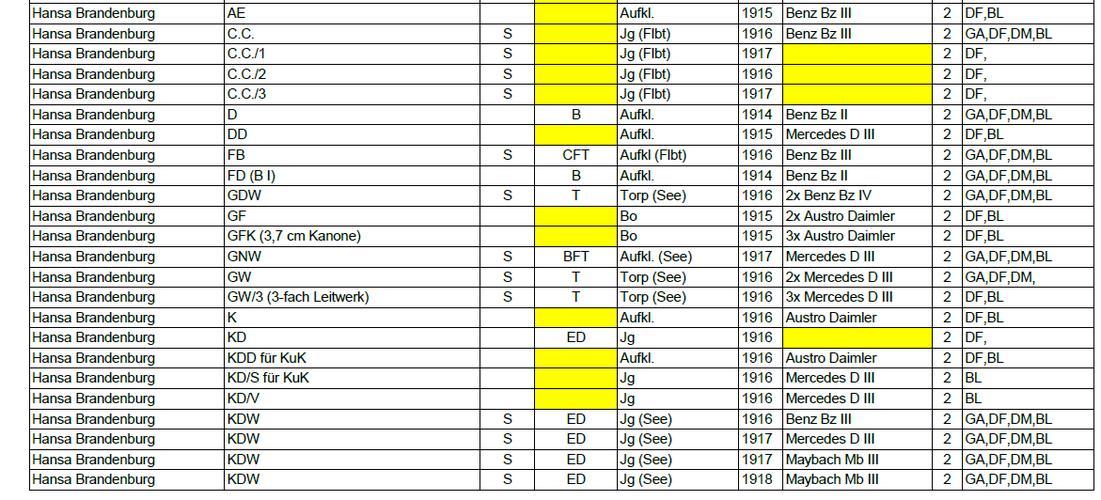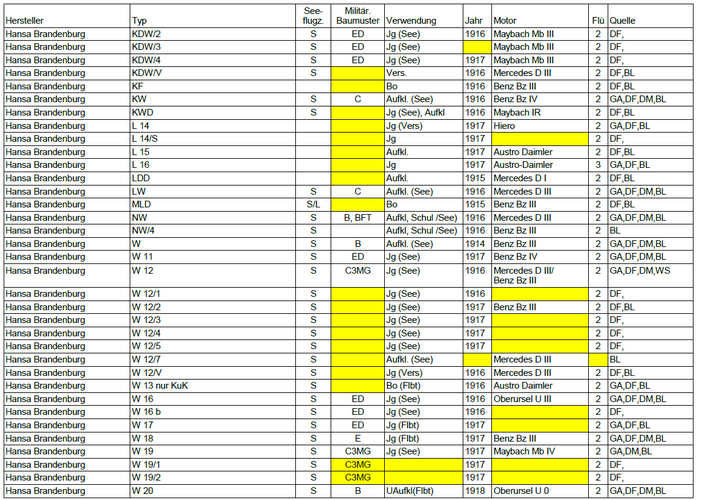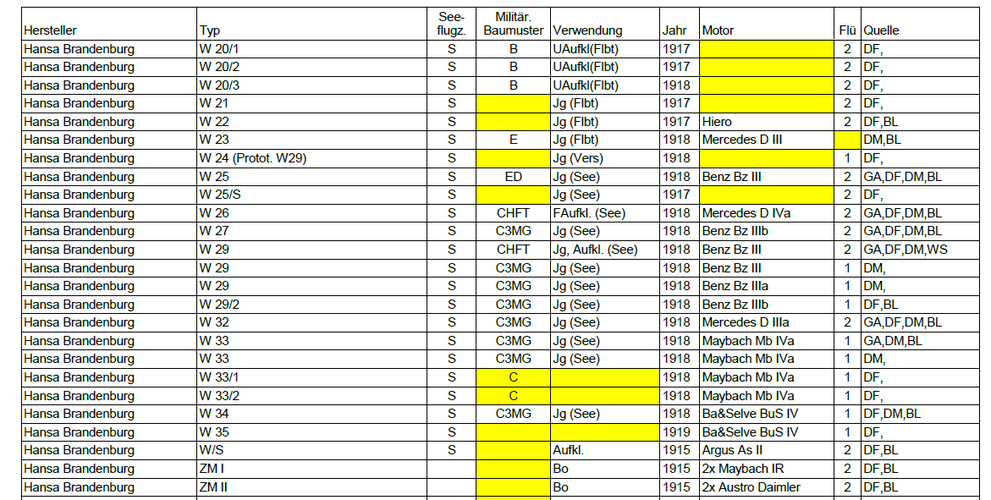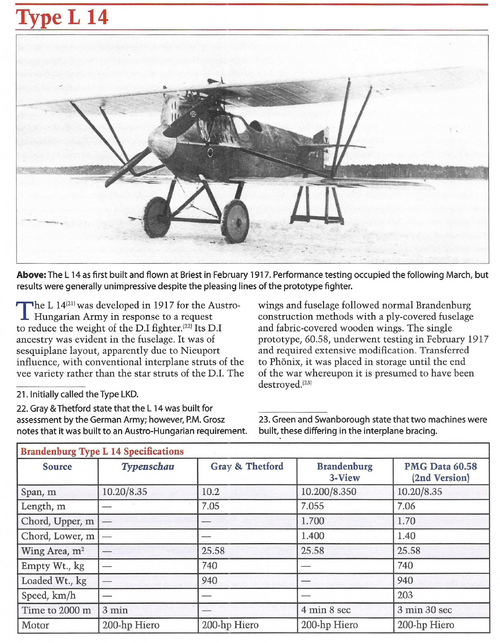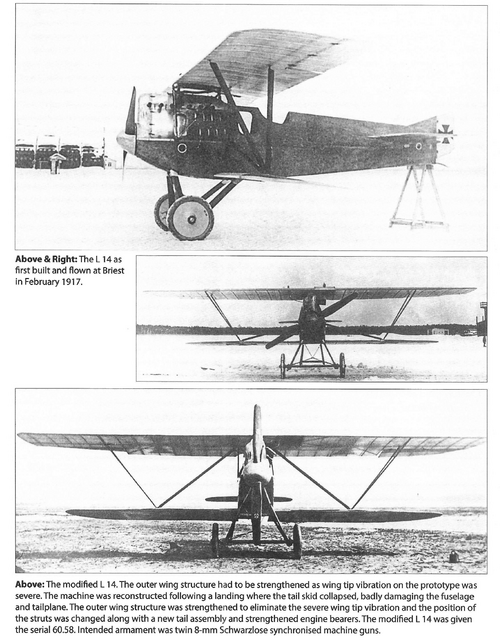I'm thinking it is useful to separate Hansa-Brandenburg type designations from the Idflieg role designators and other military designations. I've arranged my list of Hansa-Brandenburg type designations alphabetically (to make searching simpler) rather than chronologically or by related types.
Some of the entries found in other Hansa-Brandenburg lists don't seem to fit. I'm guessing that the Hansa-Brandenburg "AE' is confusion with the post-WWI Czech B.I build - the Aero Ae 01. AFAIK, those listings with slashes followed by Arabic numerals are all individual airframe numbers - not designations. I have no idea what to do with 'W-25/S' (or 'L-14S')!
The 'Triplane' makes no sense - obviously, Germans would use the term
Dreidecker. In any case, I suspect this reference is actually to the Hansa-Brandenburg L.16 prototype - so we know the correct internal designation. 'ZM.I' is a 'rationalizing' back-formation from the ZM.II - the first prototype should be plain ZM.
The GFK added a cannon ('K' for
Kanone) not another engine. It was simply a twin-engined GF with that 3.7 cm Škoda gun fitted for trials. The KuK Luftstreitkräfte designations for the GFK was G.IK, just as the original GF was their G.I.
On my list, I have included the 'numbered W' designations despite being uncertain whether these are Hansa-Brandenburg type designations (which I suspect) or numbers applied by the Kaiserliche Marine. Does anyone know for sure?
At the end of my Hansa-Brandenburg designation list, I have appended some post-WWI Swedish typ designations. This is just to avoid confusion. Often these postwar airframes are referred to 'Hansa typ
x' despite Caspar having taken over by then. In fairly short order, all those floatplanes would be given 'HE' (Heinkel Eindecker) designations.
__________________________________________
Hansa-Brandenburg Internal Designations
_________________________________________________
Hansa-Brandenburg B.I = Idflieg desig.; see typ D
Hansa-Brandenburg B.I = KuKLT desig.; see typ FD
Hansa-Brandenburg C.I = KuKLT desig.; see typ DD
Hansa-Brandenburg C.I = KuKLT desig.; see typ LDD
Hansa-Brandenburg C.II = KuKLT desig.; see typ K
Hansa-Brandenburg C.II = KuKLT desig.; see typ KDD
Hansa-Brandenburg typ CC - Flying boat fighter, x 73
- Typ CC : 'Star-Strutter' biplane w/ pusher-propeller
- Typ CC : (DE) 150 hp Benz Bz.III 6-cyl.; span 9.30 m
- Typ CC : (AH) 160 hp Austro-Daimler or 180 hp Hiero
-- Typ CC : After Camillo Castiglioni, H-B
Vorstand/CEO
-- Typ CC : KuK Kriegsmarine's designation was KDW
-- KDW =
Kampf Doppeldecker Wasser
-- NB: CC/1, CC/2, CC/3 ... are indiv. airframe numbers
Hansa-Brandenburg D.I = KuKLT desig.; see typ KD
Hansa-Brandenburg typ D - 1914 2-seat, recce biplane
- Typ D : Unarmed, tandem-seat, 2-bay biplane; x 12
- Typ D : 1 x 110 hp Benz Bz II 6-cylinder; span 13.128 m
- Typ D : Enters Fliegertruppen service as the B.I trainer
Hansa-Brandenburg typ DD - Typ DD prototype; led to C.I
- Typ DD : 1 x 160 hp Mercedes 6-cylinder; span 13.12 m
-- Typ DD served with KuKFT under
Flugzeugnummer 05.07
Hansa-Brandenburg typ FB - 1915 scout flying boat biplane, x (?)
- Typ FB : Sequiplane pusher based on A-H Lohner L scout design
- Typ FB : 1 x 150 hp Benz Bz III; span (upper) 16 m (lower) 10 m
- Typ FB : 6 x FBs to Kaiserlichen Marine for trials; most to A-H
- Typ FB (UFAG Typ K): 1 x 175 hp Rapp* 6-cylinder inline pusher
-- * UFAG Typ Ks also had 200 hp Hiero or 185 hp Austro-Daimler
- Typ FB (UFAG Typ K): Wing V-struts (rather than H-B's parallel)
-- Typ FB =
Flugboot
Hansa-Brandenburg typ FD - 1914 2-seat recce biplane, x 9
- Typ FD : Refined and improved Typ D (
qv) development
- Typ FD : 1 x 100 hp Argus I 6-cylinder; span 13.10 m
- Typ FD : Accepted for service as Hansa-Brandenburg B.I
Hansa-Brandenburg G.I = KuKFT desig.; see typ GF (below)
Hansa-Brandenburg G.IK = KuKFT desig.; see typ GF (below)
Hansa-Brandenburg typ GDW - 1916 torpedo floatplane, x 1
- Typ GDW: Enlarged, more powerful Typ GW deriv. (qv)*
- Typ GDW: 2 x 200 hp Benz Bz IV 6-cyl., span 24.50 m
-- * Typ GDW was to carry a larger torpedo than typ GW
-- Typ GDW =
Großer Doppeldecker, Wasser
Hansa-Brandenburg typ GF - 1916 twin-engined bomber for KuK
- Typ GF : 3-bay biplane with metal-tube 'scaffolding' for engines
- Typ GF : 2 x 2 160 hp Austro-Daimler 6-cylinders, span 18.00 m
- Typ GF : 1915 orders for 72 x refined Typ GFs for AH as KuK G.I*
-- * Cut back to 48 x H-B built G.Is and 24 x UFAG built G.I(U)s
-- Typ GF =
Großes Flugzeug (Large Airplane); see also Typ ZM
- Typ GFK: 1916 prototype armed with 3.7 cm Škoda L/23 cannon
- Typ GFK: 'K' for '
Kanone'; KuK desig. G.IK; assigned to Flik 59
Hansa-Brandenburg typ GNW - 1916 3-bay patrol floatplane, x 16
- Typ GNW: Refined variant of unarmed Typ NW (Marine typ B)
- Typ GNW: 1 x 160 hp Mercedes D.III 6-cylinder, span, 16.20 m
- Typ GNW: Comp. w/ NW, shorter upper span, longer fuselage
Hansa-Brandenburg GRP - (??) 1916 bomber (??)
- GRP: Endless Wiki listings but can't find any other source(s)
Hansa-Brandenburg typ GW - 1916 torpedo floatplane, x ~20
- Typ GW : Enlarged typ GF design; 3-bay biplane, twin floats
- Typ GW : 2 x 160 hp Mercedes D.III tractors, span 21.56 m
- Typ GW : To carry 1 x 725 kg torpedo between the floats
-- Typ GW =
Großflugzeug, Wasser
Hansa-Brandenburg typ K - 1916 2-seat recce biplane, x 2
- Typ K : 2-seat 'Star-Strutter' type; derived from Typ KDB
- Typ K : 1 x 180 hp Austro-Daimler 6-cylinder; span 9.40 m
-- KuK designation C.II assigned but not adopted for service
-- Typ K =
Kampfflugzeug (Combat aircraft)
Hansa-Brandenburg typ KD - 1916 single-seat biplane fighter
- Typ KD : 'Star-Strutter' type; refined as KuK's D.I fighter
- Typ KD : 1 x 160 hp Austro-Daimler 6-cylinder, span 8.51 m
-- Typ KD =
Kampf Doppeldecker (combat biplane)
Hansa-Brandenburg typ KDB - (??)
Hansa-Brandenburg typ KDD - 1916 2-seat recce biplane
- Typ KDD: Prototype recce type, x 2, leads to KuKLT C.II
- Typ KDD: 1 x 160 hp Daimler; span 11.27 m (upper), 10.32 m
- Typ KDD: Deep fuselage, no cabane struts, star-strutted
Hansa-Brandenburg typ KDW - Single-seat floatfighter, x 58
- Typ KDW: Based on typ KD, additional outboard struts
- Typ KDW: Built Sept 1916-Feb 1918; led to W.11 & W.25
-- Typ KDW =
Kampf Doppeldecker, Wasser
Hansa-Brandenburg KDW = Marine desig.; see typ CC
-- Duplicate designation or internal vs military desig.?
Hansa-Brandenburg typ KF - 1916 2-seat recce-fighter, x 1
- Typ KF : Prototype 2-bay biplane, twin-boomed pusher
- Typ KF : 1 x 150 hp Benz Bz III 6-cylinder; span 11.60 m
-- Typ KF devel. abandoned (no advantage over Ago C.I)
Hansa-Brandenburg typ KW - 1916 armed floatplane, x 3
- Typ KW : 2-bay biplane, tandem 2-seat armed recce a/c
- Typ KW : 1 x 200 hp Benz Bz IV 6-cylinder; span 6.40 m
-- Underpowered; designed for a 260 hp Mercedes D IVa
Hansa-Brandenburg typ L.14 - 1917 single-seat biplane fighter
- Typ L.14 : Intended as D.I (typ KD) replacement for KuKLT
- Typ L.14 : 1 x 200 hp Hiero 6-cylinder; span 10.20 m
- Typ L.14 : Not accepted; 2 x prototypes only; struts differed
- Typ L.14S: (??) plural confusion?
Hansa-Brandenburg L.15 - 1917 2-seat recce biplane, x 1
- Typ L.15 : Meant for KuKLT; conventional 2-bay biplane
- Typ L.15 : 1 x 350 hp Austro-Daimler V-12; span 13.60 m
Hansa-Brandenburg L.16 - 1917 single-seat triplane fighter
- Typ L.15 : Single-struts; meant for KuKLT; no orders; x 1
- Typ L.15 : 1 x 185 hp Austro-Daimler 6-cyl.; span 9.00 m
Hansa-Brandenburg typ LDD - 1916 2-seat recce biplane, x 1,318
- Typ LLD: Armed type derived from the earlier Typ FD (above)
- Typ LLD: Various 6-cylinder inline engines; span 13.20 m
- Typ LLD: Austro-Hungarian KuK designation was C.I *
-- * For H-B built + C.I(Ph) for Phönix- and C.I(U) UFAG-built
- Typ LW : LLD conv. to floatplane; 1 or 2 conv. (sources vary)
Hansa-Brandenburg typ LW - 1916 2-seat recce floatplane, x 1
- Typ LW : Revised Typ DD/C.I biplane airframe w/ twin floats
- Typ LW : 1 x 160 hp Mercedes D.III 6-cylinder; span 12.40 m
- Typ LW : Prototype operational w/ Marine from Warnemünde
Hansa-Brandenburg typ NW - 1916 naval recce floatplane, x 61
- Typ NW : Tandem 2-seat, 3-bay biplane, twin-float recce a/c
- Typ NW : 1 x 160 hp Mercedes D III 6-cylinder; span 16.27 m
- Typ NW : Intended as a higher-perf. replacement for typ W
-- 2 x typ NW variants for Kaiserliche Marine: 13 x B; 48 x BFT
-- Marine desig. B : Unarmed 'maritimes Aufklärungsflugzeug'
-- Marine desig. BFT: Typ B with FT-Sender radio transmitter
-- Gotha WD 6: aka Typ NW(Go); 30 x license-built typ NWs
-- NB: 1917, typ NWs fitted with wheeled u/c for training use
Hansa-Brandenburg typ MLD - 1915 2-seat recce biplane
- Typ MLD: Prototype military multi-purpose type, x 1
- Typ MLD: 1 x 150 hp Benz Bz.III pusher; span 16.50 m
-- MLD =
Marine Land Doppeldecker (Sea Land Biplane)
Hansa-Brandenburg typ W - 1914 2-seat, 3-bay floatplane
- Typ W: 1 x 150 hp Benz Bz III 6-cylinder; span 16.50 m
- Typ W/S: (??) plural confusion?
-- Typ W =
Wasserflugzeug
Hansa-Brandenburg W.11 - Single-seat, twin-float fighter
- W.11: Enlarged, more powerful KDW; 200 hp Benz Bz.IV
- W.11: 1 x 200 hp Benz Bz.IV 6-cylinder; span 10.10 m
- W.11: 'Star-strutter'; only minor improv. on typ KDW
--
Marinenomenklatur = ED (
Einsitziges Doppeldecker)
Hansa-Brandenburg W.12 - 1916 2-seat float recce-fighter
- W.12 : Enlarged KDW; parallel struts; underslung tail
- W.12 : 1 x 160 hp Mercedes D.III; span 9.60 m; x 136
--
Marinenomenklatur = C3MG
Hansa-Brandenburg W.13 - 1916 2-seat bomber flying boat
- W.13 : 'Almost Warren Truss' wing struts; pusher propeller
- W.13 : 1 x 360 hp Austro-Daimler 360hp V-12; span 20.40 m
- W.13 : Adopted by A-H; licensed by Oeffag, Phönix, & UFAG
Hansa-Brandenburg W.15 - (??)
Cross and Cockade mention
Hansa-Brandenburg W.16 - 1917 single-seat float-fighter, x 3
- W.16 : V-strut sesquiplane; twin floats; in parallel w/ W.12
- W.16 : 1 x 160 hp Oberursel U.III rotary; span 9.25 m
- W.16 : Tested by Deutsche Marine but no orders placed
- W.16b: (??) no details
Hansa-Brandenburg W.17 - 1917 experimental flying boat
- W.17: Parallel develop't sharing W.18 hull/empennage
- W.17: 1 x 150 hp Benz Bz.III 6-cylinder; span 9.30
- W.17: Prototype,* cantilever lower wing (span 8.75 m)
-- * 1 or 2 prototypes?; 1 to KuK Seefliegerkorps as 49/I
-- * Some sources suggest 2nd prototype was the W.22
Hansa-Brandenburg W.18 - 1917 flying boat fighter
- W.18 : Single-seat fighter biplane flying boat, x 49
-- W.18 : Marine trials a/c; 1 x 150 hp Benz Bz.III; x 2
-- W.18 : KuK 1 x 165 hp Hiero 6; span 10.70 m; x 47
Hansa-Brandenburg W.19 - 1918 enlarged evol. of W.12
- W.19 : Tandem 2-seat fighter-recce floatplane; x 55
- W.19 : 1 x 250 hp Maybach Mb.IV 6-cyl.; span 13.80 m
Hansa Brandenburg W.20 - 1917* pusher flyingboat, x 3
- W.20: Single-seater, Warren Truss biplane recce type
- W.20: 1 x 80 hp Oberursel U.0 rotary, span 6.80 m
-- * Order date?; W.20/1 & W.20/2 1917; W.20/3 1918
Hansa Brandenburg W.21 - (Project?) 1917 flying boat
- W.21 : 2-seat flyingboat recce-fighter; no other details
-- See reply
#10
Hansa-Brandenburg W.22 - 1917 experimental flying boat, x 1
- W.22: Parallel devel. to W.17; differed in wing arrangement*
- W.22: 1 x 200 hp Hiero 6-cylinder pusher prop, span 9.30 m
-- * Non-cantilever lower wing; struts joining uppers/lowers
-- W.22 used to test tip-float design for Zepplein-Lindau Rs.IV
Hansa-Brandenburg W.23 - 1918 experimental flying boat, x 1*
- W.23: W.18 deriv. to test 2 cm Becker** autocannon install'n
- W.23: 1 x 160 hp Mercedes D.III; span (upper/lower) 10.70 m
-- * 3 x prototypes built (nr 1647-1649) but only 1 completed?
-- **Total 150 rounds of 20x70mmRB (in 10-rd box magazines)
Hansa-Brandenburg W.24 – 1918 float-fighter prototype, x 1
- W.24: One-off W.24 was prototype for the W.29 series (qv)
Hansa-Brandenburg W.25 - 1917 float-fighter prototype, x 1
- W.25: Effectively typ KDW with convential wing struts
- W.25: 1 x 150 hp Benz Bz.III 6-cylinder; span 10.40 m
-- W.25: (As built) nr.2258; ailerons on upper wings only
-- W.25: (As mod.) Ailerons on both wings;* no order given
-- * Attempt to compete with better handling Albatros W.4
Hansa-Brandenburg W.26 - 1917 biplane recce floatplane
- W.26: Tandem 2-seater, 2-bay biplane with twin floats
- W.26: 1 x 260 hp Mercedes D.IV 8-cylinder; span 18.80 m
- W.26: Intended as long-range recce a/c; x 3; no orders
-- W.26
Marinenummern 1739, 1740, and 1741
Hansa-Brandenburg W.27 - 1918 2-seat float recce-fighter
- W.27: Prototype; intended as possible W.12 replac.; x 1
- W.27: 1 x 150 hp Benz Bz.IIIb 6-cylinder; span 11.20 m
-- W.27 was a parallel devel. with W.32 differing in engine
Hansa-Brandenburg W.29 - 1918 2-seat float-fighter
- W.29 : Low monoplane adaptation of W.12 biplane
- W.29 : 1 x 150 hp Benz Bz.III 6-cyl.; span 13.50 m
- W.29 : 78 x built by H-B (+ 131 more built abroad)
--
Marinenomenklatur = C3MG (2 x 7.92 mm lMG 08)
--
Marinenomenklatur = C2MGHFT (1 x lMG 08 + R/T)
Hansa-Brandenburg W.30 - (??)
- W.30: (??) 1 source suggests U.1 internal desig.*
-- * IE: Stowable W.20 variant for submarine use
--
Marinenummern 2590-2592 (for U.1 not 'W.30')
Hansa-Brandenburg W.31 - (??)
- W.31: Possibly an R type flying boat design
Hansa-Brandenburg W.32 - 1918 2-seat float recce-fighter
- W.32: Prototype; intended as possible W.12 replac.; x 1
- W.32: 1 x 160 hp Mercedes D.III 6-cylinder; span 11.20 m
-- W.32 was a parallel devel. with W.27 differing in engine
Hansa-Brandenburg W.33 - 1918 2-seat float recce-fighter
- W.33: Enlarged, more-powerful development of W.29
- W.33: 1 x 245 hp Maybach Mb.IV; span 15.85 m; x 26*
-- * Few in action, most W.33s built abroad after WWI
Hansa-Brandenburg W.34 - 1918 2-seat float recce-fighter
- W.34: Parallel development to W.33 w/ BuS.IVa engine
- W.34: Basse und Selve BuS.IVa 6-cylinder; span 15.85 m
Hansa-Brandenburg W.35 - 1917 experimental flying boat, x 1
- W.35: W.23 deriv. to test 2 cm Becker* autocannon installation
- W.35: 1 x 160 hp Mercedes D.III; span (upper/lower) 10.70 m
-- * 3 x prototypes built (nr 1647-1649) but only 1 completed?
Hansa-Brandenburg W.37 - (Project) 1918 2-seat float-fighter
- W.37: Higher-performance, reduced-scale W.33 derivative
- W.37: 1 x 220 hp Benz Bz.IV 6-cylinder; span 17.70 m
-- W.37 fuselage formed basis of postwar Caspar S I design
Hansa-Brandenburg Z.I - (??) typo for 'ZM I', ie: ZM (??)
Hansa-Brandenburg typ ZM - 1915 twin-engined bomber
- Typ ZM : 3-seat, 4-bay biplane 'battleplane' prototype
- Typ ZM : 2 x 160 hp Maybach IRs; spans 27.50/26.73 m
- Typ ZM : Prototype for Kaiserliche Marine; aka 'ZM I'
- Typ ZM II: Revised prototype for KuK Luftfahrtruppe*
-- * ZM II prototype served AH; Flugzeugnummer 05.05
- Typ ZM II: 2 x Austro-Daimlers; span (upper) 18.00 m
-- Typ GF: (qv) Refined, 3rd ZM prototype; becomes G.I
__________________________________________
Caspar-werke/Heinkel Developments for Sweden
Typ 31 - 1921 Caspar/Svenska Aero-built W.29 deriv.; x 1
- Typ 31: 1 x 260 hp Maybach IV 6-cylinder, span 17.48 m
-- Swedish mil. desig. S I; aka Caspar S.I & Heinkel HE 1
Typ 32 - 1922-1923 production variant of Typ 31; x 10
- Typ 32: 1 x 260 hp Maybach IVA 6-cylinder, span 17.48 m
-- Swedish mil. desig. S I; aka Caspar S.I & Heinkel HE 1
Typ 42 - 1924-1927 Swedish SA/CFS production; x 4 + 2
- Typ 42: Enlarged, 3-seat development; aka '
Rolls-Hansa'
- Typ 42: 1 x 360 hp R-R
Eagle IX V-12, span 17,49 m
-- Swedish mil. desig. S II; aka Caspar S.II, Heinkel HE 2
Typ 47 - 1926 Swedish CFS production variant; x 1
- Typ 47: Enlarged, 3-seat development
- Typ 47: 1 x 360 hp R-R
Eagle IX V-12, span 18.00 m
-- Swedish mil. desig. S IIa/S III; aka Heinkel HE 4
__________________________________________



